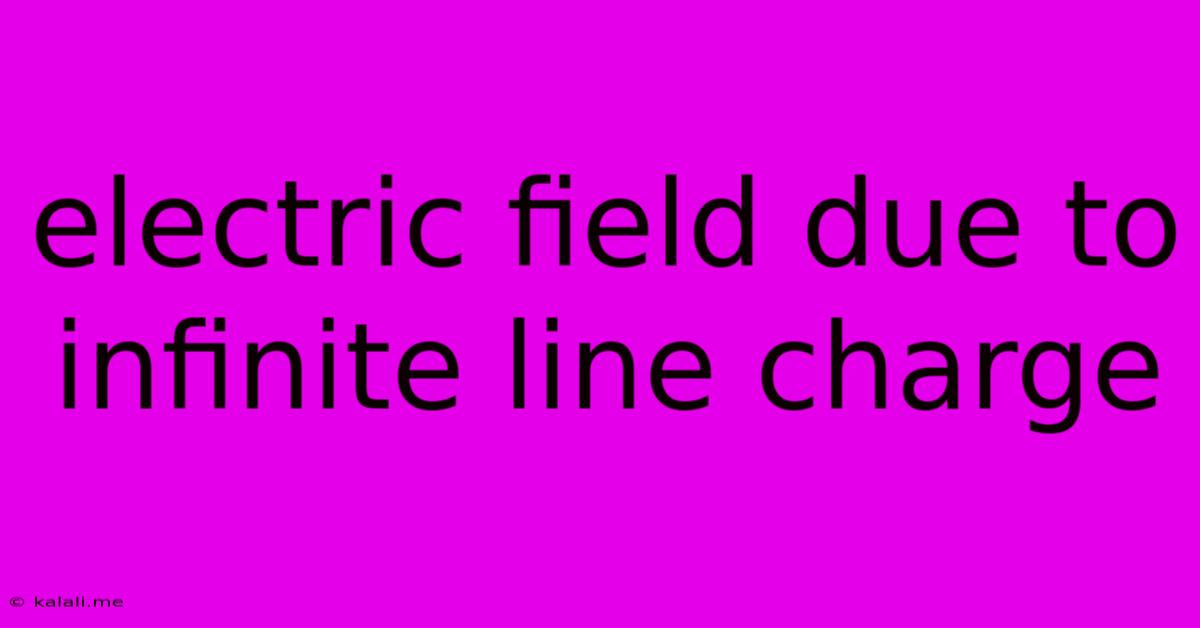Electric Field Due To Infinite Line Charge
Kalali
Jun 13, 2025 · 3 min read

Table of Contents
Electric Field Due to an Infinite Line Charge: A Comprehensive Guide
Meta Description: This article provides a comprehensive explanation of how to calculate the electric field produced by an infinitely long line charge, covering Gauss's law and its application, with detailed steps and helpful visuals.
Understanding the electric field generated by an infinite line charge is a fundamental concept in electrostatics with applications in various fields, including physics and electrical engineering. This article will guide you through the calculation using Gauss's Law, providing a clear and concise explanation. While a truly infinite line charge is a theoretical construct, this model offers valuable approximations for scenarios involving long, thin charged objects.
What is an Infinite Line Charge?
An infinite line charge is a theoretical model representing a uniformly charged line extending infinitely in both directions. This simplification allows for easier calculation of the electric field without the complexities of finite length effects. The linear charge density, denoted by λ (lambda), represents the charge per unit length along the line and is measured in Coulombs per meter (C/m).
Calculating the Electric Field Using Gauss's Law
Gauss's Law provides a powerful tool for calculating the electric field due to symmetrical charge distributions. It states that the flux of the electric field through a closed surface is proportional to the enclosed charge. Mathematically, it's represented as:
∮ E • dA = Q<sub>enc</sub> / ε₀
Where:
- E is the electric field vector
- dA is a vector representing a small area element on the Gaussian surface, pointing outward
- Q<sub>enc</sub> is the total charge enclosed within the Gaussian surface
- ε₀ is the permittivity of free space (8.854 x 10<sup>-12</sup> C²/Nm²)
For an infinite line charge, we choose a cylindrical Gaussian surface with its axis coinciding with the line charge. This choice is strategic because of the cylindrical symmetry of the electric field.
Steps to Calculate the Electric Field
-
Choose a Gaussian Surface: Construct a cylindrical Gaussian surface of radius r and length L around a segment of the infinite line charge.
-
Determine the Electric Field: Due to the symmetry, the electric field E is radial and has a constant magnitude at every point on the cylindrical surface. The electric field vector is perpendicular to the circular ends of the cylinder, resulting in zero flux through these surfaces. The flux is only non-zero through the curved cylindrical surface.
-
Calculate the Flux: The flux through the curved surface is given by:
∮ E • dA = E * 2πrL (since E is parallel to dA on the curved surface)
- Determine the Enclosed Charge: The total charge enclosed within the Gaussian surface is simply the linear charge density multiplied by the length of the cylinder:
Q<sub>enc</sub> = λL
- Apply Gauss's Law: Substituting the flux and enclosed charge into Gauss's Law:
E * 2πrL = λL / ε₀
- Solve for the Electric Field: Solving for the electric field E, we get:
E = λ / (2πε₀r)
This equation shows that the electric field due to an infinite line charge is inversely proportional to the distance r from the line charge.
Key Observations and Applications
- The electric field is directed radially outward (or inward, depending on the sign of λ).
- The magnitude of the electric field decreases with distance from the line charge.
- This model is useful for approximating the electric field of long, thin charged objects, such as a long charged wire.
- The concept is crucial for understanding more complex electrostatic problems and forms the basis for further studies in electromagnetism.
This detailed explanation provides a solid understanding of the electric field calculation for an infinite line charge. Remember that this is a theoretical model, but it serves as a valuable tool for approximating real-world scenarios involving long, thin charged objects. Understanding this fundamental concept is crucial for advancing your knowledge of electrostatics and its applications.
Latest Posts
Latest Posts
-
Middle Tennessee State University Act Requirements
Jun 14, 2025
-
How Long Is The Penalty Spot From The Goal
Jun 14, 2025
-
Which Cycle Is Not A Major Biogeochemical Cycle
Jun 14, 2025
-
Good Conductor Of Heat And Electricity Metal Or Non Metal
Jun 14, 2025
-
Which Of The Following Statements About Interjections Is False
Jun 14, 2025
Related Post
Thank you for visiting our website which covers about Electric Field Due To Infinite Line Charge . We hope the information provided has been useful to you. Feel free to contact us if you have any questions or need further assistance. See you next time and don't miss to bookmark.